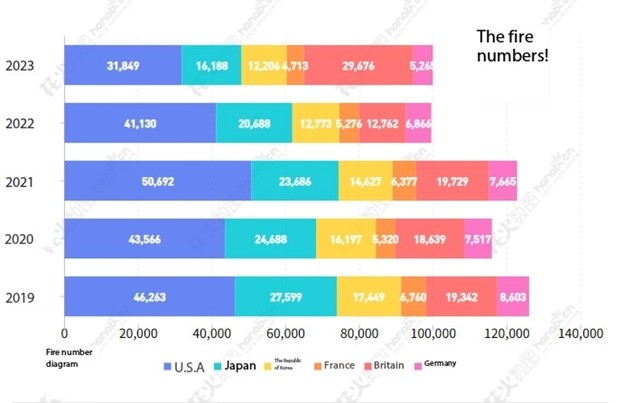Data Analysis and Trend of Trademark Market and Ranking of IP Agencies in China and Worldwide
According to the statistical data of the China Intellectual Property Administration, the numbers of trademark applications, opposition applications and review cases for the years from 2019 to 2023 are as follows.
In 2023, the total number of trademark applications was 7.18 million, showing a decrease of about 178 thousand compared to 2022. There were 115,000 trademark opposition applications, a decrease of about 30,700, and 410,000 trademark reviews, down about 12,000.
Top Agencies
We like to underline that in the analysis of the Top 10 IP Agencies of 12 selected Countries (the United States, Japan, South Korea, Germany, France, the United Kingdom, Italy, the Netherlands, Spain, Sweden, Denmark, Singapore), HFG stands out as first in Italy, second in Spain, ninth in Sweden. This great achievement is the demonstration of HFG's high level of professionalism.
Data analysis

The overall number of reviews has decreased slightly, with a decline of about 12,000. But the downturn is narrower than the 2022 data.
The rejections of reexamination still account for the largest share of trademark review and adjudication activities, with 76% in 2023.
The number of reexamination cases of non-registration has increased significantly, and trademark opponents (trademark applicants) have also taken more vigorous "counter-feedback" against trademark opposition decisions than before, and further requested rights relief through follow-up procedures.
The number of reexamination cases for the cancellation of registration has increased significantly, and the number of cases for the cancellation of indirect certification trademarks has also increased, which shows that the official standard for similar recognition in the examination of trademark registration applications has become stricter.
In order to eliminate the obstacles caused by the cited trademark, the trademark registration applicants have to submit a large number of applications for cancellation, which makes the number of cancellation cases increasing significantly.
In accordance with the usual practice of trademark rejection and reexamination, the general strategy for citing trademarks is to argue that they are not similar, cancel the trademark, oppose the trademark, invalidate the trademark, or negotiate transfer.
However, under the current strict standards of trademark similarity recognition, the probability of success of simple argument is low. Due to the crackdown on malicious hoarding of trademarks, applications for the transfer of trademark transactions have been strictly examined, and commercial activities such as negotiating the transfer of trademarks have also been greatly curbed.
As a result, applications for cancellation of cited trademarks have been filed to remove obstacles. In particular, recently, the Trademark Office has strictly judged the evidence of trademark use, and the probability of success in initiating a trademark cancellation application has greatly increased.
In the Working System for the Examination and Trial of Trademark Review and Adjudication Cases issued last year, the Trademark Office has also issued the following measures: In combination with the actual review work, the "Norms for the Suspension of Review Cases" has been added, which is more humane in handling the suspension of review of rejected review cases, and the right holder is more inclined to use the revocation application as corroborating evidence in the review process, so as to strive to obtain rights in the review process.
Data analysis of Major Countries
The "foreign and domestic" trademark business is a very representative type of business segment in the intellectual property agency industry, which is characterized by strong professional ability, high language requirement, high unit price, strong commercial requirement and strong brand dependence of suppliers.
The data presented below take into consideration six countries, namely, the United States, Japan, South Korea, Germany, France, and the United Kingdom.

All of the above six countries showed a downward trend, with the exception of the number of applications from the United Kingdom.
Among the above six countries, the proportion of US applicants entering China is as high as 41.34%. American companies have demonstrated their huge economic strength and the identity of the United States as China's main trading partner. Accordingly, the United States should also be the largest source of business for foreign intellectual property services.
Global view
Based on WIPO World Intellectual Property Indicators 2023, since 2022 global trademark applications have declined by 15.7%.
For example, the UK trademark applications fell by 21.5%, the United States by 14.7%, Germany by 14.2%, Australia by 13.4%, Canada by 12.7%.
The number of trademark applications in the world's major economies has declined in the past, while the number of trademark applications in emerging economies such as Türkiye, Indonesia, Russia, Brazil, Vietnam, and India has increased to varying degrees.
In 2022, 83.5% of trademark applicants chose to file their trademark applications in their home country rather than internationally.
When designing an overseas trademark layout, applicants typically consider a number of factors, including the attractiveness of foreign markets to sell their goods and services, geographical proximity to those markets, and historical ties between the trademark holder's home country and the destination country.
In 2022, almost a quarter (24.4%) of international trademark registration applications received in China came from US applicants, followed by Japan (11.7%) and the UK (8.5%). Together, applicants from these three countries accounted for 44.6% of all non-resident trademark registrations in China that year.
On the other side, the majority of foreign applicants filed in America were from China, accounting for 43% of all foreign applications.
The number of trademark applications worldwide declined during 2001 and 2002 and the financial crisis of 2008-2009, but today it's still 2.5 times higher than in 2001. So, in the long term the prevision is that trademark applications will continue to grow.
Source: 2023年度商标数据综合分析、主要国家进入中国申请量及代理机构排名——数据分析“外内”商标市场,评析代理机构发展方向|行业|领先的全球知识产权产业科技媒体IPRDAILY.CN.COM


